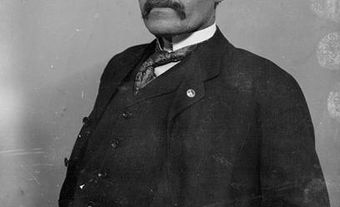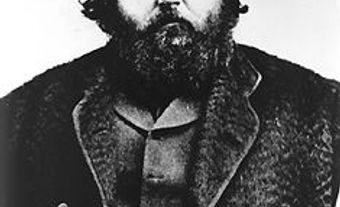
Early Life
Norris was born into a wealthy Edmonton, Alberta family in 1900. His father John Norris, a Scottish settler, had made his fortune in the fur trade. His mother Euphrosine Plante, a Métis woman from St. Albert, Alberta, was John’s third wife. It was not a smooth blending of families: the children from earlier marriages lived in a separate household and were openly hostile towards their new stepmother and her offspring.
Young Malcolm Frederick Norris grew up in St. Albert and received a Catholic education. A good student, he was fluent in English, French and Cree. He hoped to attend university but once his father died, there were no financial provisions for this, so he began farming instead.
Military Service
At age 18, Malcolm Frederick Norris left farming and joined the army. He enlisted in late August 1918, less than two months before the end of the First World War. After training in Regina, Saskatchewan, he served from late August to mid-December, 1918 as a member of the North-West Mounted Police, Siberian Calvary. The unit was supposed to go overseas to fight in the Russian Civil War, but Norris was discharged as part of natural demobilization at the end of the war and therefore, never saw active duty.
When the Second World War began, Malcolm Frederick Norris joined the Royal Canadian Air Force. Despite serving from 1940–45, Norris never went overseas and did his entire service in Ontario and then Calgary, Alberta. His son Russell joined the army during the Second World War but was killed in Normandy, France in 1944, at the age of 20. Another one of his sons, Arnold William (known as “Willy”) also served in the war and spent time in a prisoner of war camp.
Life and Work in Northern Alberta
Malcolm Frederick Norris started working for the Hudson’s Bay Company (HBC) at Fort Vermilion in northern Alberta in 1919. However, he left after growing disheartened by the company’s trading monopoly and sometimes unethical fur pricing policies with Indigenous people. Norris transferred to Little Red River in 1921 to work as the assistant postmaster and trapped furs near Camsell Portage.
Until 1930, he worked as a trapper and trader at his own trading post (established in 1923), when he and his family moved to Edmonton for the children’s education. Around 1928–30 Norris became a prospector. During his work in northern Alberta, Norris saw the poor living conditions of Métis and other Indigenous peoples, which drove him to seek social and economic changes for those communities.
Political Activism in Alberta
Like his Métis friend and fellow activist, Jim Brady, Malcolm Frederick Norris became an avid Marxist and democratic socialist in the 1920s. He was active in the Communist Party.
Often introducing himself as “Redskin Norris,” Norris lobbied for Métis rights and social equality. Together with fellow Métis leaders Jim Brady, Peter Tomkins, Felix Callihoo and Joseph Francis Dion (known together as “the big five”), Malcolm Frederick Norris helped to form l’Association des Métis d’Alberta et des Territoires du Nord-Ouest (now the Métis Nation of Alberta) in 1932. He served as first vice-president of the organization, which lobbied the provincial government to improve the social and economic conditions of Métis and Non-Status Indian people. (See also Indian.)
Intense lobbying by Malcolm Frederick Norris and his fellow Métis leaders led to the appointment of the provincial Royal Ewing Commission in 1934. It heard testimony and made recommendations regarding the poverty, health problems and lack of education of the province’s Métis people. Known for his quick wit, sharp tongue and fiery, passionate speeches, Malcolm Frederick Norris acted as spokesperson for the Métis leaders at the proceedings. Alberta’s Métis Association sought autonomy for their people and a cooperative venture with the provincial government. The commission, however, did not view the Métis people as partners, stating, “It is perfectly true that these people are like children, helpless and irresponsible.” Indeed, Norris experienced a great deal of racism in his interactions with the commission.
Following recommendations of the Ewing Commission, the Alberta government passed the Métis Betterment Act in 1938. This Act was Canada’s first Métis-specific legislation. It gave Métis people in Alberta land settlements (i.e., colony lands for them to live on) and social welfare programs. However, Malcolm Frederick Norris was upset that the Métis held little control over their colony lands in Alberta and did not gain a direct benefit from resources used by the government, such as fish, fur and timber. Of the 12 colony lands created by the Act, four settlements have since dissolved, but eight remain. Legislation enacted since the 1990s has increased the degree of self-government in these areas.
In addition to his work in l’Association des Métis d’Alberta et des Territories du Nord-Ouest, Malcolm Frederick Norris was also active in the Indian Association of Alberta (IAA). This was a First Nations rights organization founded in 1939 by John Callihoo and John Laurie. The IAA and other Indigenous organizations lobbied for changes to the Indian Act and for improved social and living conditions for Indigenous people. Norris provided organizational advice to IAA executive in 1930s and 1940s. Called the “old lawyer” by some chiefs, Norris also helped gain rights for Treaty Indians in Alberta. (See also Treaties with Indigenous Peoples in Canada and Indian.)
Political Activism in Saskatchewan
After serving in the Second World War, Malcolm Frederick Norris did not settle in the Alberta Métis colonies, which he had helped create. He resented the provincial government’s intervention there in Métis affairs. Instead, along with Jim Brady, he settled in northern Saskatchewan, turning his hopes towards the Co-operative Commonwealth Federation (CCF), which had gained power in that province in 1944. Having formed a close friendship in Alberta, Norris and Brady hoped to organize the Métis base in Saskatchewan.
Malcolm Frederick Norris worked for the CCF government’s Department of Mineral Resources. While in that position, he started a prospectors’ incentive plan, which helped many Indigenous peoples receive training in prospecting. Starting in 1944, he also advised the CCF on matters relating to Indigenous peoples in province.
From the late 1940s to the 1960s, Malcolm Frederick Norris strived to unify the province’s two rival Métis organizations: the Métis Association of Northern Saskatchewan, which he directed in 1964, and the Saskatchewan Métis Society, based in the south. During this time, he attended meetings with many chiefs to help them organize.
With Jim Brady, Malcolm Frederick Norris helped found the Métis Association of Saskatchewan. Both men held a common goal: complete economic independence for Indigenous people in the north of Saskatchewan. They wanted to cast off government dependence, control the north’s natural resources and gain revenues from future development. Norris also advocated for an independent Métis nation in Saskatchewan.
Norris was forced to retire from public service in January 1965 by the provincial Liberal government. He became the executive director of the Indian/Métis Friendship Council (a friendship centre). However, Norris resigned in June 1966, after the Liberal government threatened to withhold provincial funding from the organization unless he was fired. The government defended their actions by saying Norris’s political views distracted from the social service aspect of the agency.
Though his health began failing (having suffered first a heart attack in 1956 and then a stroke and another heart attack in 1966), Malcolm Frederick Norris remained active in Métis politics and community life. He continued to attend meetings of the Métis Association, though later, in a wheelchair.
DID YOU KNOW?
At a July 1962 ceremony, on behalf of the province’s Métis people, Malcolm Frederick Norris spoke in Batoche, Saskatchewan, where the Métis commemorated their final military battle with federal troops in 1885. (See also North-West Rebellion.) Norris strived to redefine Canada’s perception of historical Métis leaders Louis Riel and Gabriel Dumont as dangerous rebels. He concluded with the words: “Canada today is a great nation, but it is necessary for me to remind you that the conditions of my people and the Indians of Canada is a blot on our country. If Canada is to continue to make progress in the years ahead, it is necessary for the Canadian people and their governments to remove this blot.”
Death and Legacy
Malcolm Frederick Norris moved back to Alberta in 1967, where he suffered another stroke and died in Calgary. He is remembered for his devotion to Métis organizations. A skilled political organizer, Norris was involved with many Indigenous political organizations in Alberta and Saskatchewan for over 30 years. He is also remembered as a strident and passionate speaker who always spoke his mind during a political meeting or debate.
A memorial was held in September 1975 for Malcolm Frederick Norris at the Indian-Métis Friendship Centre in Prince Albert, Saskatchewan. ( See also Friendship Centres.) Frank Tomkins, the son of Norris’s friend and fellow activist Peter Tomkins, said to applause, “Malcolm Norris has left some very impressive footprints on those sands of time.”

 Share on Facebook
Share on Facebook Share on X
Share on X Share by Email
Share by Email Share on Google Classroom
Share on Google Classroom




